With the ongoing COVID-19 pandemic, nursing shortages, and increasing patient acuity, nurses face unprecedented challenges in providing high-quality patient care.
When nurse-to-patient ratios are unsafe, it can lead to burnout, high turnover, and unsafe patient care.
Even with today’s nursing shortage, you can proactively head off unsafe ratios.
By prioritizing safe staffing practices and utilizing tools like patient acuity assessments and scheduling software, you can improve nurse-to-patient ratios, leading to better patient outcomes and a healthier workforce.
Today, we’ll cover the current state of nurse-to-patient ratios and what you can do to improve yours by addressing:
- What is a Nurse-to-Patient Ratio?
- Why Do We Need Nurse-to-Patient Ratios?
- How Can You Establish Safe Nurse-to-Patient Ratios?
- MakeShift Scheduling Supports Safe Nurse-to-Patient Ratios
- Frequently Asked Questions
What is a Nurse-to-Patient Ratio?
“Nurse-to-patient ratio” refers to the number of nurses assigned to care for a certain number of patients during a shift.
In a nutshell, it measures how many patients a nurse is responsible for.
A higher nurse-to-patient ratio means each nurse has more patients to care for, which can lead to an increased workload and compromise the quality of care.
On the flip side, a lower nurse-to-patient ratio means each nurse has fewer patients to care for, which can lead to better care and more personalized attention for each patient.
How do ratios affect nurses?
High nurse-to-patient ratios can negatively impact nurses, leading to burnout and job dissatisfaction due to the increased workload and decreased quality of patient care.
However, when there are appropriate nurse-to-patient ratios, nurses can provide better care and have more time to focus on individual patient needs, leading to happier nurses and better patient outcomes.
Current Nurse-to-Patient Ratios
Nurse-to-patient ratios can vary depending on the healthcare setting and acuity.
It's imperative for healthcare facilities to regularly evaluate and adjust their staffing levels to ensure their nurses can provide safe and effective care while also maintaining their health and well-being.
There’s currently no national policy in the U.S. mandating nurse staffing ratios.
States with nurse-to-patient ratios vary significantly, with some states having policies (not mandates) to enforce staffing ratios.
There are 3 approaches that many states use to enforce their set policies:
- Nurse-driven staffing committee to oversee ratios
- Specific ratios mandated through state legislation
- Staffing ratios of facilities disclosed to the public
The Department for Professional Employees lists Connecticut, Illinois, Nevada, Ohio, Oregon, Texas, and Washington as states that require hospitals to have committees responsible for enforcing staffing policies.
Illinois, New Jersey, New York, Rhode Island, and Vermont require hospitals to report staffing ratios publicly.
California is the ONLY state to implement a ratio mandate.
Wondering about a safe guideline for nurse-to-patient ratios should be?
Who is better at setting ratios than front-line workers?
Nurses.
The following are proposed nurse-to-patient ratios based on acuity from National Nurses United:
- Operating Room Trauma Patient in ER 1:1
ICU, Neonatal ICU, Post-anesthesia, Labor & Delivery, Coronary Care, Burn Unit, and Acute Respiratory Care 1:2 - Antepartum, Combined L&D and post-partum, Post-partum Couplets Pediatrics, ER, Stepdown, Telemetry 1:3
- Intermediate Care Nursing, Med/Surg, Psychiatric, Other Specialty Care Units 1:4
- Rehab, Silled Nursing Facility 1:5
- Well Baby Nursery 1:6
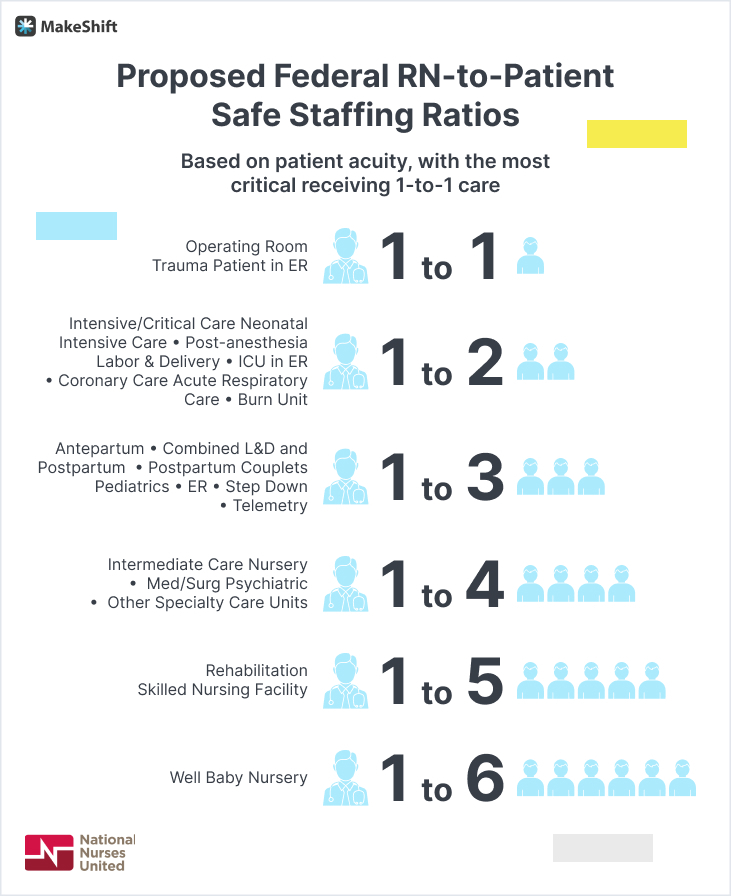
Why Do We Need Nurse-to-Patient Ratios?
Safe nurse staffing is essential for providing high-quality patient care and ensuring the safety of both patients and nurses.
When there are too many patients for 1 nurse to care for, it can lead to:
- Fatigue
- Burnout
- Increased stress levels
- Compromised quality of care
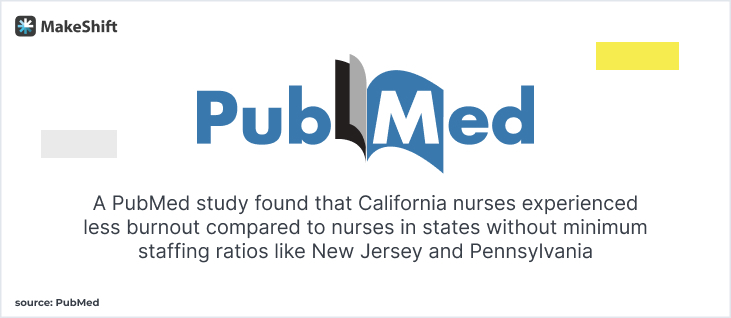
A PubMed study found that California nurses experienced less burnout than those in states without minimum staffing ratios, like New Jersey and Pennsylvania.
Safe nurse-to-patient ratios mainly affect 3 areas of the healthcare industry:
1. Patient Care
A 2019-2021 study found that there were 164,592 potentially preventable patient safety events that took place in U.S. hospitals among Medicare patients.
A key part of preventing these potential events (which hospitals often have to pay for) is having safe nurse-to-patient ratios.
When more nurses are available to care for patients, they’re better able to detect and respond to changes in a patient's condition, which can prevent complications and potentially save lives. 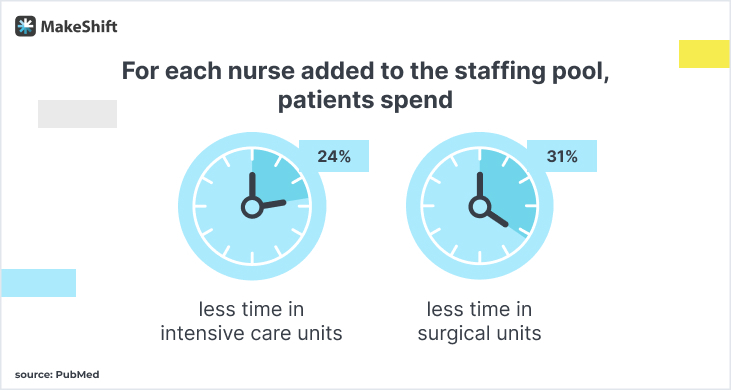
For each nurse added to the staffing pool, patients spend 24% less time in intensive care units and 31% less time in surgical units.
Here’s a true story that I once had to experience:
My grandmother was supposed to have a quick, 3-day hospital stay to qualify for rehab, but she never came home.
The hospital utilized highly dangerous nurse-to-patient ratios, which led to devastating results.
My grandmother wasn’t properly repositioned every 2 hours and developed a stage 4 pressure ulcer of her sacrum. Because her foley catheter was improperly cared for and maintained, she developed an infection that led to sepsis.
She spent her last days in hospice before she passed away.
As an RN with 15 years of experience, I know this was a preventable tragedy.
2. Nursing Staff
Safe nurse-to-patient ratios are also important for nurses, who deserve a safe and supportive work environment.
Unsafe ratios can cause nurses to be forced to resign or refuse assignments — when this happens, morale plummets, and attrition follows.
The same hospital from the story above was also being sued by nurses who had been fired after refusing to accept an assignment where they were assigned 7 patients on a cardiac unit where the ratio should have been 1:4.
That’s almost double the safe number of heart patients.
3. The Hospital’s Reputation
Imagine the impact on a hospital’s reputation and brand perception when they have patients dying and nurses suing them based on unsafe conditions.
That ultimately leads to patients avoiding the facility like the plague because they don't trust the care provided.
This then impacts nurse perception — they don't want to work somewhere that has a rep for being unsafe.
So, not only have they lost patients, they can’t get nurses to work there.
How Can You Establish Safe Nurse-to-Patient Ratios?
Ensuring safe nurse-to-patient ratios is essential for a plethora of reasons.
Safe ratios help ensure patients receive the high-quality care they deserve without overworking their nurses. When there aren't enough nurses, things fall through the cracks, and mistakes can happen.
Plus, when nurses are overworked, it can lead to burnout and a high turnover rate, which isn’t good for your facility, your patients, or your nurses.
Here are 7 ways to ensure safe nurse-to-patient ratios in your healthcare facility.
1. Regularly assess staffing levels
Nursing managers should monitor staffing levels regularly to ensure that there are enough nurses to meet patient needs.
Using staff scheduling software to plan shifts can give you better insight into monitoring your staffing levels.
2. Use patient acuity tools
Patient acuity tools can help nursing managers determine the appropriate staffing levels based on the severity of patients' conditions.
Using a patient acuity tool can benefit nurses by providing a standardized method for assessing patient needs and the distribution of patients.
This leads to better patient outcomes and improved job satisfaction among nurses.
3. Utilize float nurses
Float nurses can be used to fill gaps in staffing during periods of high patient volume or unexpected absences.
Assign float nurses to units that have higher patient volume or acuity. This allows for workload redistribution and prevents nurses from being overworked and patients receiving suboptimal care.
4. Consider nurse workload
You should consider the workload of each nurse when assigning patient care responsibilities.
Double-check that no nurse is overloaded with more patients than they can safely manage.
5. Implement flexible scheduling
Implementing flexible scheduling can help ensure there are enough nurses available during peak times and can reduce burnout and turnover rates.
Flexible scheduling allows your nurses to schedule work around their lives and lets them feel more in control of their schedules.
6. Involve nurses in staffing decisions
Involve your nurses in staffing decisions — ask for their input and communicate with them (in advance) about any changes that may impact their workload.
When your nurses feel like they have a say in their schedules and the staffing decisions at your facility, you’ll notice an improvement in their engagement at work.
7. Monitor and evaluate outcomes
Regularly monitor and evaluate outcomes related to staffing levels to ensure patient care is not compromised and that nurses are working in a safe and supportive environment.
How MakeShift Scheduling Supports Safe Nurse-to-Patient Ratios
MakeShift scheduling can help support safe nurse-to-patient ratios by providing real-time data on staff availability and qualifications.With this info, you can make more informed staffing decisions, ensuring you have enough nurses to meet patient needs without overburdening individual nurses.
MakeShift scheduling can also help to minimize scheduling errors and conflicts, which can lead to unsafe ratios.
Streamline your scheduling and ensure safe nurse-to-patient ratios with these key features:
- Real-time staffing updates — MakeShift can provide real-time updates on staffing levels, allowing you to quickly identify staffing gaps and make adjustments as needed to ensure safe nurse-to-patient ratios.
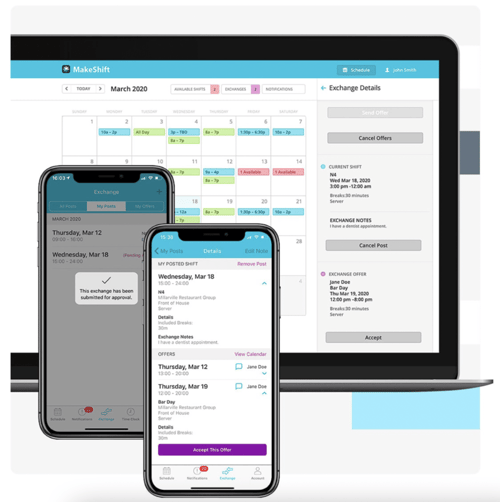
- Automated scheduling — Automatically fill shifts when nurses call out to maintain a healthy nurse-to-patient ratio.
- Requests and availability — MakeShift lets your nurses submit staffing requests and update their availability, which gives you up-to-date info when scheduling and helps to ensure nurses are assigned to the right shifts based on availability.
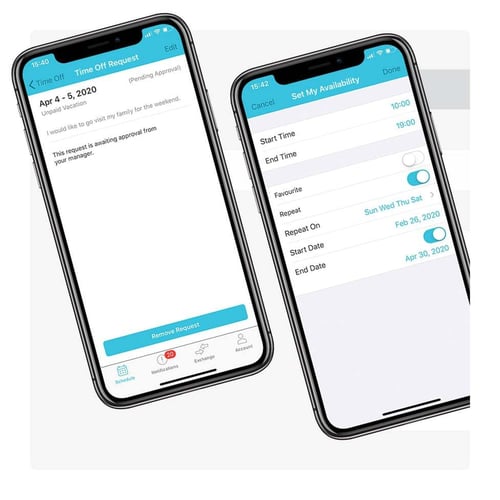
- Mobile access — MakeShift is accessible on mobile devices, allowing nurses to access their schedules and staffing information from anywhere, making it easier for them to manage their schedules and be available when needed.
.jpg?width=500&height=500&name=schedule_pocket_(1).jpg)
By providing real-time staffing updates and automated scheduling, MakeShift can help RN managers optimize staffing levels and ensure that nurses are assigned to the right shifts to provide safe and high-quality care to patients.
Nurse-to-Patient Ratios Matter
By making sure you’ve got enough nurses to meet patient needs, everyone benefits — patients get better care, nurses are happier and more productive, and healthcare facilities can run more smoothly.
MakeShift can streamline your scheduling process to help you stay on top of safe nurse-to-patient ratios.
Ready to take a step forward for a better nurse experience?
Schedule a free demo today.
Frequently Asked Questions
Here are more answers to your top nurse-to-patient ratio questions:
What is the safest nurse-to-patient ratio?
There isn’t a stock answer for this. Calculating safe nurse-to-patient ratios involves taking into account various factors like patient acuity, nurse experience, and the complexity of care required.
What is the problem with nurse-to-patient ratios?
A problem only occurs when the ratios are out of whack. The problem with nurse-to-patient ratios is that inadequate staffing levels compromise patient safety and quality of care and put nurses’ well-being in jeopardy.
Is there a limit to how many patients a nurse can have?
There certainly should be! A nurse’s patient number assignment should be determined by 4 things:
- Patient acuity
- Nurse’s experience
- Type of patient care required
- Number of support staff
Which state has the highest nurse-to-patient ratio?
These days it’s California (probably because they’re the only state with a mandate on the books).
Who opposes nurse staffing ratios?
You’d think it would be no one, but you’d be mistaken. The opposition to nurse staffing ratios typically comes from groups like healthcare providers, hospital administrators, and policymakers.
Some opponents argue that mandatory nurse staffing ratios would be too costly and inflexible, leading to a decrease in access to healthcare services and potentially harming patient care.





